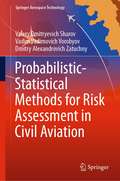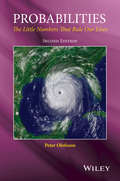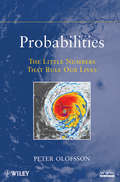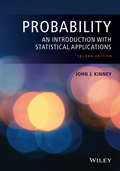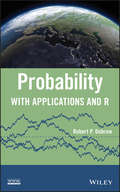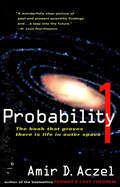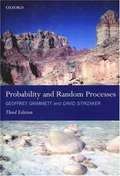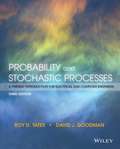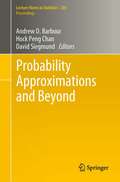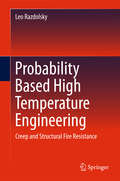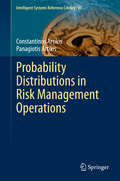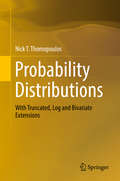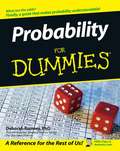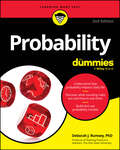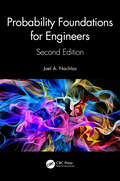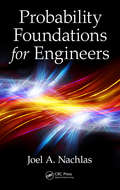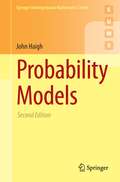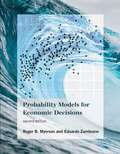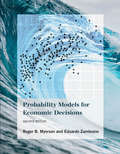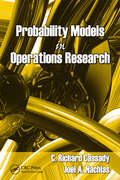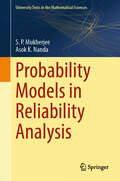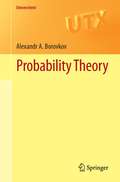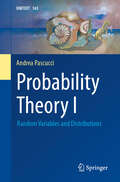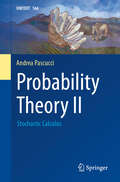- Table View
- List View
Probabilistic-Statistical Methods for Risk Assessment in Civil Aviation (Springer Aerospace Technology)
by Dmitry Alexandrovich Zatuchny Valery Dmitryevich Sharov Vadim Vadimovich VorobyovThis book analyses the models for major risks related to flight safety in the aviation sector and presents risk estimation methods through examples of several known aviation enterprises. The book provides a comprehensive content for professionals engaged in the development of flight safety regulatory framework as well as in the design and operation of ground-based or on-board flight support radio electronic systems. The book is also useful for senior students and postgraduates in aviation specialties, especially those related to air traffic management.
Probabilities
by Peter OlofssonPraise for the First Edition"If there is anything you want to know, or remind yourself, about probabilities, then look no further than this comprehensive, yet wittily written and enjoyable, compendium of how to apply probability calculations in real-world situations."- Keith Devlin, Stanford University, National Public Radio's "Math Guy" and author of The Math Gene and The Unfinished GameFrom probable improbabilities to regular irregularities, Probabilities: The Little Numbers That Rule Our Lives, Second Edition investigates the often surprising effects of risk and chance in our lives. Featuring a timely update, the Second Edition continues to be the go-to guidebook for an entertaining presentation on the mathematics of chance and uncertainty. The new edition develops the fundamental mathematics of probability in a unique, clear, and informal way so readers with various levels of experience with probability can understand the little numbers found in everyday life. Illustrating the concepts of probability through relevant and engaging real-world applications, the Second Edition features numerous examples on weather forecasts, DNA evidence, games and gambling, and medical testing. The revised edition also includes:The application of probability in finance, such as option pricingThe introduction of branching processes and the extinction of family namesAn extended discussion on opinion polls and Nate Silver's election predictionsProbabilities: The Little Numbers That Rule Our Lives, Second Edition is an ideal reference for anyone who would like to obtain a better understanding of the mathematics of chance, as well as a useful supplementary textbook for students in any course dealing with probability.
Probabilities: The Little Numbers That Rule Our Lives
by Peter OlofssonWhat are the chances? Find out in this entertaining exploration ofprobabilities in our everyday lives “If there is anything you want to know, or remind yourself, about probabilities, then look no further than this comprehensive, yet wittily written and enjoyable, compendium of how to apply probability calculations in real-world situations.” — Keith Devlin, Stanford University, National Public Radio’s “Math Guy” and author of The Math Gene and The Math Instinct “A delightful guide to the sometimes counterintuitive discipline of probability. Olofsson points out major ideas here, explains classic puzzles there, and everywhere makes free use of witty vignettes to instruct and amuse.” — John Allen Paulos, Temple University, author of Innumeracy and A Mathematician Reads the Newspaper “Beautifully written, with fascinating examples and tidbits of information. Olofsson gently and persuasively shows us how to think clearly about the uncertainty that governs our lives.” — John Haigh, University of Sussex, author of Taking Chances: Winning with Probability From probable improbabilities to regular irregularities, Probabilities: The Little Numbers That Rule Our Lives investigates the often-surprising effects of risk and chance in our everyday lives. With examples ranging from WWII espionage to the O. J. Simpson trial, from bridge to blackjack, from Julius Caesar to Jerry Seinfeld, the reader is taught how to think straight in a world of randomness and uncertainty. Throughout the book, readers learn: Why it is not that surprising for someone to win the lottery twice How a faulty probability calculation forced an innocent woman to spend three years in prison How to place bets if you absolutely insist on gambling How a newspaper turned an opinion poll into one of the greatest election blunders in history Educational, eloquent, and entertaining, Probabilities: The Little Numbers That Rule Our Lives is the ideal companion for anyone who wants to obtain a better understanding of the mathematics of chance.
Probability
by John J. KinneyPraise for the First Edition"This is a well-written and impressively presented introduction to probability and statistics. The text throughout is highly readable, and the author makes liberal use of graphs and diagrams to clarify the theory." - The StatisticianThoroughly updated, Probability: An Introduction with Statistical Applications, Second Edition features a comprehensive exploration of statistical data analysis as an application of probability. The new edition provides an introduction to statistics with accessible coverage of reliability, acceptance sampling, confidence intervals, hypothesis testing, and simple linear regression. Encouraging readers to develop a deeper intuitive understanding of probability, the author presents illustrative geometrical presentations and arguments without the need for rigorous mathematical proofs. The Second Edition features interesting and practical examples from a variety of engineering and scientific fields, as well as:Over 880 problems at varying degrees of difficulty allowing readers to take on more challenging problems as their skill levels increaseChapter-by-chapter projects that aid in the visualization of probability distributionsNew coverage of statistical quality control and quality productionAn appendix dedicated to the use of Mathematica® and a companion website containing the referenced data setsFeaturing a practical and real-world approach, this textbook is ideal for a first course in probability for students majoring in statistics, engineering, business, psychology, operations research, and mathematics. Probability: An Introduction with Statistical Applications, Second Edition is also an excellent reference for researchers and professionals in any discipline who need to make decisions based on data as well as readers interested in learning how to accomplish effective decision making from data.
Probability
by Robert P. DobrowAn introduction to probability at the undergraduate levelChance and randomness are encountered on a daily basis. Authored by a highly qualified professor in the field, Probability: With Applications and R delves into the theories and applications essential to obtaining a thorough understanding of probability.With real-life examples and thoughtful exercises from fields as diverse as biology, computer science, cryptology, ecology, public health, and sports, the book is accessible for a variety of readers. The book's emphasis on simulation through the use of the popular R software language clarifies and illustrates key computational and theoretical results.Probability: With Applications and R helps readers develop problem-solving skills and delivers an appropriate mix of theory and application. The book includes:Chapters covering first principles, conditional probability, independent trials, random variables, discrete distributions, continuous probability, continuous distributions, conditional distribution, and limitsAn early introduction to random variables and Monte Carlo simulation and an emphasis on conditional probability, conditioning, and developing probabilistic intuitionAn R tutorial with example script filesMany classic and historical problems of probability as well as nontraditional material, such as Benford's law, power-law distributions, and Bayesian statisticsA topics section with suitable material for projects and explorations, such as random walk on graphs, Markov chains, and Markov chain Monte CarloChapter-by-chapter summaries and hundreds of practical exercisesProbability: With Applications and R is an ideal text for a beginning course in probability at the undergraduate level.
Probability 1
by D. AczelFor thousands of years, it was the visionaries and writers who argued that we cannot be alone-that there is intellegent life in the universe. Now, with the discoveries of the Hubble Telescope, data emerging from Mars, and knowledge about life at the extremes, scientists are taking up where they left off. Amir Aczel, author of Fermat's Last Theorem, pulls together everyting science has discovered, and mixes in proabability theory, to argure the case for the existence of intelligent life beyond this planet. Probability 1 is an extraordinary tour de force in which the author draws on cosmology, math, and biology to tell the rollicking good story of scientists tackling important scientific questions that help answer this fundamental question. What is the probability of intelligent life in the universe? Read this book, and you'll be convinced, by the power of the argument and the excitement of the science.
Probability And Random Processes
by David R. Stirzaker Geoffrey R. GrimmettThe third edition of this successful text gives a rigorous introduction to probability theory and the discussion of the most important random processes in some depth. It includes various topics which are suitable for undergraduate courses, but are not routinely taught. It is suitable to the beginner, and provides a taste and encouragement for more advanced work. There are four main aims: 1) to provide a thorough but straightforward account of basic probability, giving the reader a natural feel for the subject unburdened by oppressive technicalities, 2) to discuss important random processes in depth with many examples. 3) to cover a range of important but less routine topics, 4) to impart to the beginner the flavour of more advanced work. The books begins with basic ideas common to many undergraduate courses in mathematics, statistics and the sciences; in concludes with topics usually found at graduate level. The ordering and numbering of material in this third edition has been mostly preserved from the second. Minor alterations and additions have been added for clearer exposition. Highlights include new sections on sampling and Markov chain Monte Carlo, geometric probability, coupling and Poisson approximation, large deviations, spatial Poisson processes, renewal-reward, queueing networks, stochastic calculus, Itô's formula and option pricing in the Black-Scholes model for financial markets. In addition there are many (nearly 400) new exercises and problems that are entertaining and instructive; their solutions can be found in the companion volume 'One Thousand Exercises in Probability', (OUP 2001).
Probability And Stochastic Processes: A Friendly Introduction For Electrical And Computer Engineers
by David J. Goodman Roy D. YatesIn Probability and Stochastic Processes: A Friendly Introduction for Electrical and Computer Engineers, readers are able to grasp the concepts of probability and stochastic processes, and apply these in professional engineering practice. The 3rd edition also includes quiz solutions within the appendix of the text. The resource presents concepts clearly as a sequence of building blocks identified as an axiom, definition or theorem. This approach allows for a better understanding of the material, which can be utilized in solving practical problems.
Probability Approximations and Beyond
by Andrew Barbour David Siegmund Hock Peng ChanIn June 2010, a conference, Probability Approximations and Beyond, was held at the National University of Singapore (NUS), in honor of pioneering mathematician Louis Chen. Chen made the first of several seminal contributions to the theory and application of Stein's method. One of his most important contributions has been to turn Stein's concentration inequality idea into an effective tool for providing error bounds for the normal approximation in many settings, and in particular for sums of random variables exhibiting only local dependence. This conference attracted a large audience that came to pay homage to Chen and to hear presentations by colleagues who have worked with him in special ways over the past 40+ years. The papers in this volume attest to how Louis Chen's cutting-edge ideas influenced and continue to influence such areas as molecular biology and computer science. He has developed applications of his work on Poisson approximation to problems of signal detection in computational biology. The original papers contained in this book provide historical context for Chen's work alongside commentary on some of his major contributions by noteworthy statisticians and mathematicians working today.
Probability Based High Temperature Engineering
by Leo RazdolskyThis volume on structural fire resistance is for aerospace, structural, and fire prevention engineers; architects, and educators. It bridges the gap between prescriptive- and performance-based methods and simplifies very complex and comprehensive computer analyses to the point that the structural fire resistance and high temperature creep deformations will have a simple, approximate analytical expression that can be used in structural analysis and design. The book emphasizes methods of the theory of engineering creep (stress-strain diagrams) and mathematical operations quite distinct from those of solid mechanics absent high-temperature creep deformations, in particular the classical theory of elasticity and structural engineering. Dr. Razdolsky s previous books focused on methods of computing the ultimate structural design load to the different fire scenarios. The current work is devoted to the computing of the estimated ultimate resistance of the structure taking into account the effect of high temperature creep deformations. An essential resource for aerospace structural engineers who wish to improve their understanding of structure exposed to flare up temperatures and severe fires, the book also serves as a textbook for introductory courses in fire safety in civil or structural engineering programs, vital reading for the PhD students in aerospace fire protection and structural engineering, and a case study of a number of high-profile fires (the World Trade Center, Broadgate Phase 8, One Meridian Plaza; Mandarin Towers). "Probability Based High Temperature Engineering: Creep and Structural Fire Resistance" successfully bridges the information gap between aerospace, structural, and engineers; building inspectors, architects, and code officials. "
Probability Distributions in Risk Management Operations
by Constantinos Artikis Panagiotis ArtikisThis book is about the formulations, theoretical investigations, and practical applications of new stochastic models for fundamental concepts and operations of the discipline of risk management. It also examines how these models can be useful in the descriptions, measurements, evaluations, and treatments of risks threatening various modern organizations. Moreover, the book makes clear that such stochastic models constitute very strong analytical tools which substantially facilitate strategic thinking and strategic decision making in many significant areas of risk management. In particular the incorporation of fundamental probabilistic concepts such as the sum, minimum, and maximum of a random number of continuous, positive, independent, and identically distributed random variables in the mathematical structure of stochastic models significantly supports the suitability of these models in the developments, investigations, selections, and implementations of proactive and reactive risk management operations. The book makes extensive use of integral and differential equations of characteristic functions, mainly corresponding to important classes of mixtures of probability distributions, as powerful analytical tools for investigating the behavior of new stochastic models suitable for the descriptions and implementations of fundamental risk control and risk financing operations. These risk treatment operations very often arise in a wide variety of scientific disciplines of extreme practical importance.
Probability Distributions: With Truncated, Log And Bivariate Extensions (SpringerBriefs In Statistics)
by Nick T. ThomopoulosThis volume presents a concise and practical overview of statistical methods and tables not readily available in other publications. It begins with a review of the commonly used continuous and discrete probability distributions. Several useful distributions that are not so common and less understood are described with examples and applications in full detail: discrete normal, left-partial, right-partial, left-truncated normal, right-truncated normal, lognormal, bivariate normal, and bivariate lognormal. Table values are provided with examples that enable researchers to easily apply the distributions to real applications and sample data. The left- and right-truncated normal distributions offer a wide variety of shapes in contrast to the symmetrically shaped normal distribution, and a newly developed spread ratio enables analysts to determine which of the three distributions best fits a particular set of sample data. The book will be highly useful to anyone who does statistical and probability analysis. This includes scientists, economists, management scientists, market researchers, engineers, mathematicians, and students in many disciplines.
Probability For Analysts
by Karl StrombergThis book will enable researchers and students of analysis to more easily understand research papers in which probabilistic methods are used to prove theorems of analysis, many of which have no other known proofs. The book assumes a course in measure and integration theory but requires little or no background in probability theory. It emplhasizes topics of interest to analysts, including random series, martingales and Brownian motion.
Probability For Dummies
by Deborah J. RumseyWhether you're hitting the books for a probability or statistics course or hitting the tables at a casino, working out probabilities can be problematic. This book helps you even the odds. Using easy-to-understand explanations and examples, it demystifies probability -- and even offers savvy tips to boost your chances of gambling success!
Probability For Dummies
by Deborah J. RumseyLearn how to calculate your chances with easy-to-understand explanations of probability Probability—the likelihood or chance of an event occurring—is an important branch of mathematics used in business and economics, finance, engineering, physics, and beyond. We see probability at work every day in areas such as weather forecasting, investing, and sports betting. Packed with real-life examples and mathematical problems with thorough explanations, Probability For Dummies helps students, professionals, and the everyday reader learn the basics. Topics include set theory, counting, permutations and combinations, random variables, conditional probability, joint distributions, conditional expectations, and probability modeling. Pass your probability class and play your cards right, with this accessible Dummies guide. Understand how probability impacts daily life Discover what counting rules are and how to use them Practice probability concepts with sample problems and explanations Get clear explanations of all the topics in your probability or statistics class Probability For Dummies is the perfect Dummies guide for college students, amateur and professional gamblers, investors, insurance professionals, and anyone preparing for the actuarial exam.
Probability Foundations for Engineers
by Joel A. NachlasThis textbook will continue to be the best suitable textbook written specifically for a first course on probability theory and designed for industrial engineering and operations management students. The book offers theory in an accessible manner and includes numerous practical examples based on engineering applications. Probability Foundations for Engineers, Second Edition continues to focus specifically on probability rather than probability and statistics. It offers a conversational presentation rather than a theorem or proof and includes examples based on engineering applications as it highlights Excel computations. This new edition presents a review of set theory and updates all descriptions, such as events versus outcomes, so that they are more understandable. Additional new material includes distributions such as beta and lognormal, a section on counting principles for defining probabilities, a section on mixture distributions and a pair of distribution summary tables. Intended for undergraduate engineering students, this new edition textbook offers a foundational knowledge of probability. It is also useful to engineers already in the field who want to learn more about probability concepts. An updated solutions manual is available for qualified textbook adoptions.
Probability Foundations for Engineers
by Joel A. NachlasSuitable for a first course in probability theory, this textbook covers theory in an accessible manner and includes numerous practical examples based on engineering applications. The book begins with a summary of set theory and then introduces probability and its axioms. It covers conditional probability, independence, and approximations. An important aspect of the text is the fact that examples are not presented in terms of "balls in urns". Many examples do relate to gambling with coins, dice and cards but most are based on observable physical phenomena familiar to engineering students.
Probability Models
by John HaighThe purpose of this book is to provide a sound introduction to the study of real-world phenomena that possess random variation. It describes how to set up and analyse models of real-life phenomena that involve elements of chance. Motivation comes from everyday experiences of probability, such as that of a dice or cards, the idea of fairness in games of chance, and the random ways in which, say, birthdays are shared or particular events arise. Applications include branching processes, random walks, Markov chains, queues, renewal theory, and Brownian motion. This popular second edition textbook contains many worked examples and several chapters have been updated and expanded. Some mathematical knowledge is assumed. The reader should have the ability to work with unions, intersections and complements of sets; a good facility with calculus, including integration, sequences and series; and appreciation of the logical development of an argument. Probability Models is designed to aid students studying probability as part of an undergraduate course on mathematics or mathematics and statistics.
Probability Models for Economic Decisions (The MIT Press)
by Roger B. Myerson Eduardo ZambranoAn introduction to the use of probability models for analyzing risk and economic decisions, using spreadsheets to represent and simulate uncertainty.This textbook offers an introduction to the use of probability models for analyzing risks and economic decisions. It takes a learn-by-doing approach, teaching the student to use spreadsheets to represent and simulate uncertainty and to analyze the effect of such uncertainty on an economic decision. Students in applied business and economics can more easily grasp difficult analytical methods with Excel spreadsheets. The book covers the basic ideas of probability, how to simulate random variables, and how to compute conditional probabilities via Monte Carlo simulation. The first four chapters use a large collection of probability distributions to simulate a range of problems involving worker efficiency, market entry, oil exploration, repeated investment, and subjective belief elicitation. The book then covers correlation and multivariate normal random variables; conditional expectation; optimization of decision variables, with discussions of the strategic value of information, decision trees, game theory, and adverse selection; risk sharing and finance; dynamic models of growth; dynamic models of arrivals; and model risk. New material in this second edition includes two new chapters on additional dynamic models and model risk; new sections in every chapter; many new end-of-chapter exercises; and coverage of such topics as simulation model workflow, models of probabilistic electoral forecasting, and real options. The book comes equipped with Simtools, an open-source, free software used througout the book, which allows students to conduct Monte Carlo simulations seamlessly in Excel.
Probability Models for Economic Decisions, second edition (The\mit Press Ser.)
by Roger B. Myerson Eduardo ZambranoAn introduction to the use of probability models for analyzing risk and economic decisions, using spreadsheets to represent and simulate uncertainty.This textbook offers an introduction to the use of probability models for analyzing risks and economic decisions. It takes a learn-by-doing approach, teaching the student to use spreadsheets to represent and simulate uncertainty and to analyze the effect of such uncertainty on an economic decision. Students in applied business and economics can more easily grasp difficult analytical methods with Excel spreadsheets. The book covers the basic ideas of probability, how to simulate random variables, and how to compute conditional probabilities via Monte Carlo simulation. The first four chapters use a large collection of probability distributions to simulate a range of problems involving worker efficiency, market entry, oil exploration, repeated investment, and subjective belief elicitation. The book then covers correlation and multivariate normal random variables; conditional expectation; optimization of decision variables, with discussions of the strategic value of information, decision trees, game theory, and adverse selection; risk sharing and finance; dynamic models of growth; dynamic models of arrivals; and model risk. New material in this second edition includes two new chapters on additional dynamic models and model risk; new sections in every chapter; many new end-of-chapter exercises; and coverage of such topics as simulation model workflow, models of probabilistic electoral forecasting, and real options. The book comes equipped with Simtools, an open-source, free software used througout the book, which allows students to conduct Monte Carlo simulations seamlessly in Excel.
Probability Models in Operations Research (Operations Research Series)
by Joel A. Nachlas C. Richard CassadyIndustrial engineering has expanded from its origins in manufacturing to transportation, health care, logistics, services, and more. A common denominator among all these industries, and one of the biggest challenges facing decision-makers, is the unpredictability of systems. Probability Models in Operations Research provides a comprehensive
Probability Models in Reliability Analysis (University Texts in the Mathematical Sciences)
by S. P. Mukherjee Asok K. NandaThis book delves into the fundamental theoretical aspects of reliability analysis, focusing on various probabilistic models. These models are essential for representing random variations in underlying variables such as time-to-failure, the number of failures between consecutive repairs and similar metrics. The calculation, estimation and prediction of reliability all hinge on using appropriate probability models. The book introduces various models beneficial for researchers in the field of reliability. It also provides a comprehensive overview of the available models, highlighting their distinctive features and practical applications in a narrative format. The content of the book is designed to appeal to a broad readership. Students and researchers in the field of reliability analysis will find a comprehensive yet easily understandable summary of models applicable to their data sets of interest. It should be noted, however, As stated clearly in the preface, this book does not illustrate applications of the models discussed in terms of real-life data.
Probability Theory
by Alexandr A. BorovkovProbability theory is an actively developing branch of mathematics. It has applications in many areas of science and technology and forms the basis of mathematical statistics. This self-contained, comprehensive book tackles the principal problems and advanced questions of probability theory and random processes in 22 chapters, presented in a logical order but also suitable for dipping into. They include both classical and more recent results, such as large deviations theory, factorization identities, information theory, stochastic recursive sequences. The book is further distinguished by the inclusion of clear and illustrative proofs of the fundamental results that comprise many methodological improvements aimed at simplifying the arguments and making them more transparent. The importance of the Russian school in the development of probability theory has long been recognized. This book is the translation of the fifth edition of the highly successful and esteemed Russian textbook. This edition includes a number of new sections, such as a new chapter on large deviation theory for random walks, which are of both theoretical and applied interest. The frequent references to Russian literature throughout this work lend a fresh dimension and makes it an invaluable source of reference for Western researchers and advanced students in probability related subjects. Probability Theory will be of interest to both advanced undergraduate and graduate students studying probability theory and its applications. It can serve as a basis for several one-semester courses on probability theory and random processes as well as self-study. About the Author Professor Alexandr Borovkov lives and works in the Novosibirsk Academy Town in Russia and is affiliated with both the Sobolev Institute of Mathematics of the Russian Academy of Sciences and the Novosibirsk State University. He is one of the most prominent Russian specialists in probability theory and mathematical statistics. Alexandr Borovkov authored and co-authored more than 200 research papers and ten research monographs and advanced level university textbooks. His contributions to mathematics and its applications are widely recognized, which included election to the Russian Academy of Sciences and several prestigious awards for his research and textbooks.
Probability Theory I: Random Variables and Distributions (UNITEXT #165)
by Andrea PascucciThis book provides a concise yet rigorous introduction to probability theory. Among the possible approaches to the subject, the most modern approach based on measure theory has been chosen: although it requires a higher degree of mathematical abstraction and sophistication, it is essential to provide the foundations for the study of more advanced topics such as stochastic processes, stochastic differential calculus and statistical inference. The text originated from the teaching experience in probability and applied mathematics courses within the mathematics degree program at the University of Bologna; it is suitable for second- or third-year students in mathematics, physics, or other natural sciences, assuming multidimensional differential and integral calculus as a prerequisite. The four chapters cover the following topics: measures and probability spaces; random variables; sequences of random variables and limit theorems; and expectation and conditional distribution. The text includes a collection of solved exercises.
Probability Theory II: Stochastic Calculus (UNITEXT #166)
by Andrea PascucciThis book offers a modern approach to the theory of continuous-time stochastic processes and stochastic calculus. The content is treated rigorously, comprehensively, and independently. In the first part, the theory of Markov processes and martingales is introduced, with a focus on Brownian motion and the Poisson process. Subsequently, the theory of stochastic integration for continuous semimartingales was developed. A substantial portion is dedicated to stochastic differential equations, the main results of solvability and uniqueness in weak and strong sense, linear stochastic equations, and their relation to deterministic partial differential equations. Each chapter is accompanied by numerous examples. This text stems from over twenty years of teaching experience in stochastic processes and calculus within master's degrees in mathematics, quantitative finance, and postgraduate courses in mathematics for applications and mathematical finance at the University of Bologna. The book provides material for at least two semester-long courses in scientific studies (Mathematics, Physics, Engineering, Statistics, Economics, etc.) and aims to provide a solid background for those interested in the development of stochastic calculus theory and its applications. This text completes the journey started with the first volume of Probability Theory I - Random Variables and Distributions, through a selection of advanced classic topics in stochastic analysis.
